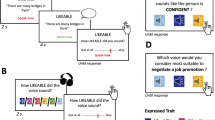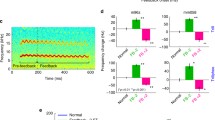Abstract
Subjects responded to the spatial location of a stimulus, either by moving a lever in the direction of the stimulus or by saying the direction into a microphone connected to a computer-controlled speech recognition system. Both manual and vocal reaction times increased as a function of the number of response alternatives (1, 2, or 4 directions) and decreased when rapid responding was differentially reinforced. Vocal responding generally was slower, and effects of increasing the number of response alternatives were more pronounced. This last finding, together with the method used to record vocal latencies, argued against the possibility that slower responding was an artifact of the recording systems. The results showed the feasibility of using vocal responses in steady-state analyses of human operant behavior. The manual-vocal differences may have been a consequence of the directionality of the manual response. Movements toward a stimulus are closely controlled by contingencies inherent within the response-stimulus relationship, whereas vocal responses pertaining to direction must be established and maintained by the less reliable verbal community.
Similar content being viewed by others
References
BARON, A., & MENICH, S. R. (1985). Reaction times of older and younger men: Effects of compound samples and a prechoice signal on delayed matching-to-sample performances. Journal of the Experimental Analysis of Behavior, 44, 1–14.
BARON, A., MENICH, S. R., & PERONE, M. (1983). Reaction times of younger and older men and temporal contingencies of reinforcement. Journal of the Experimental Analysis of Behavior, 40, 275–287.
BARON, A., & PERONE, M. (1982). The place of the human subject in the operant laboratory. The Behavior Analyst, 5, 143–158.
GONZALEZ, F. A., & WALLER, M. B. (1974). Handwriting as an operant. Journal of the Experimental Analysis of Behavior, 21, 165–175.
GREENSPOON, J. (1962). Verbal conditioning and clinical psychology. In A. J. Bachrach (Ed.), Experimental foundations of clinical psychology. New York: Basic Books.
HEARST, E., & JENKINS, H. M. (1974). Sign tracking: The stimulus-reinforcer relation and direct action. Austin, TX: Psychonomic Society.
LANE, H. L., & SHINKMAN, P. G. (1963). Methods and findings in an analysis of a vocal operant. Journal of the Experimental Analysis of Behavior, 6, 179–188.
LUCE, R. D. (1986). Response times: Their role in inferring elementary mental organization. New York: Oxford University Press.
MAZUR, J. E. (1986). Learning and behavior. Englewood Cliffs, NJ: Prentice-Hall.
MICHAEL, J. (1984). Verbal behavior. Journal of the Experimental Analysis of Behavior, 42, 363–376.
MILLER, L. K. (1968). Escape from an effortful situation. Journal of the Experimental Analysis of Behavior, 11, 619–627.
SALTHOUSE, T. A. (1985). Speed of behavior and its implications for cognition. In J. E. Birren & K. W. Schaie (Eds.), Handbook of the psychology of aging (2nd ed.). New York: Van Nostrand Reinhold.
WELFORD, A. T. (1980). Reaction times. New York: Academic Press.
Author information
Authors and Affiliations
Additional information
Supported by Grant AG02513 from the National Institute on Aging. We gratefully acknowledge valuable assistance provided by Patricia Powers in collecting and analyzing data. Thanks also are due to colleagues with whom we discussed the findings and interpretations, particulary Eugene Eisman and John Hay.
Rights and permissions
About this article
Cite this article
Baron, A., Journey, J.W. Reinforcement of Human Reaction Time: Manual-Vocal Differences. Psychol Rec 39, 285–296 (1989). https://doi.org/10.1007/BF03395069
Published:
Issue Date:
DOI: https://doi.org/10.1007/BF03395069




